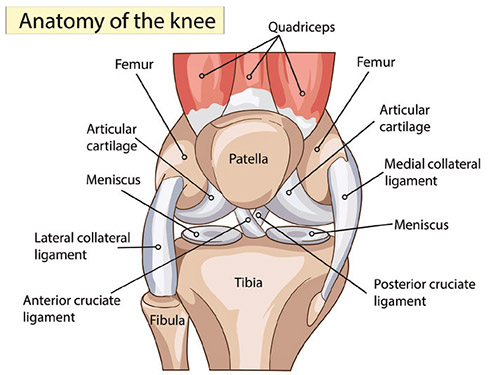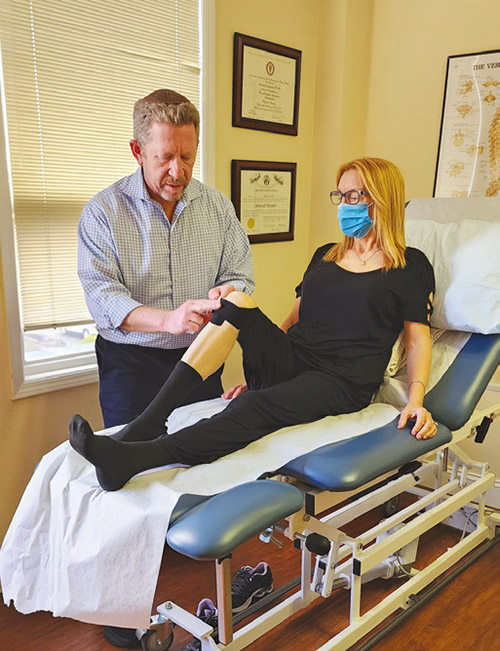
Osteoarthritis (OA) of the knee is a very common condition that affects millions of people worldwide. It typically starts to develop between the ages of 40 and 60, but some even have it earlier on. Knee OA can lead to pain, stiffness and difficulty with mobility. Unfortunately, approximately 46% of people will develop it sometime during their lifetimes.While there is as yet no cure for OA, the good news is that physical therapy can absolutely help manage the symptoms and improve quality of life for those who are affected.

What is Osteoarthritis of the Knee? (Very Basic Anatomy)
To understand how physical therapy can help manage knee OA, it is important to understand the anatomy of the knee joint. The knee joint is made up of three bones: the femur (thigh bone), the tibia (shin bone) and the patella (kneecap). The ends of these bones are covered in a layer of cartilage, which acts as a cushion and allows for smooth movement of the joint.
Knee OA results from inflammation and wear and tear of the articular cartilage between the bones of the knee.Your cartilage is like a shock absorber, protecting your body from bumps and jolts. You can wear out or damage your knee joint cartilage if:
You’re overweight. If your body mass index (BMI) is 30 or more, you’re seven times more likely to develop OA in your knee than someone with a lower BMI.
You injure your knee or have an old knee injury.
You frequently put stress on your knee at your job or playing sports.
You inherited a tendency to develop OA of the knee.
You have crooked bones or joints, such as having knocked knees.

Symptoms of Knee Osteoarthritis
Morning stiffness lasting less than 30 minutes
Pain during or after activity. Examples include walking, climbing or going down stairs, or rising from a chair to stand.
Pain or stiffness after sitting with the knee bent or straight for a long time
A feeling or sound of popping, cracking or grinding when moving the knee
Swelling after activity
Tenderness to touch along the knee joint
How Can Physical Therapy Help?
Physical therapy has been proven in multiple studies to successfully manage knee OA. Seeing a physical therapist early can help slow the progression of the condition and prevent it from becoming worse. Proper treatment also can help people delay or avoid surgery.
Physical therapy for knee OA focuses on the following:
Range of motion of the knee and surrounding joints
Modalities (cold laser, ultrasound, electrical stim) for pain and swelling
Strengthening of the muscles around the knee
Manual therapy (patella mobilizations and soft-tissue massage)
Kinesio taping
Bracing and orthotics recommendations
Motion Is Lotion!
When it comes to managing knee OA, one of the most important things to remember is that motion is lotion! What that means is that to ensure proper lubrication of the joint, it needs to move throughout its range. While it may seem counterintuitive, staying active and maintaining range of motion in the knee can actually help reduce pain and stiffness and improve overall function. In addition to proper overall range of motion of the knee, it is also very important to have proper patella mobility. In many instances, the patella is restricted in its motion. A physical therapist can help free up restrictions and tightness by performing very specific mobilizations to the patella to help increase overall knee range of motion and help reduce pain.
Strength Is Key!
In addition to the bones and cartilage, the knee joint is surrounded by several muscles and ligaments that help support and stabilize the joint. The VMO muscle (vastus medialis oblique) is particularly important for knee stability, as it helps keep the patella in the proper position. The hamstrings, iliopsoas muscle, ITB band, quadriceps and calf muscles also play a role in knee stability and mobility.
A major part of physical therapy for knee OA focuses on strengthening the muscles around the knee joint to reduce stress on the cartilage and improve joint stability. Strengthening exercises for the VMO muscle and quadriceps can be particularly effective, as these muscles help support the patella and improve joint alignment. Examples of exercises that can help strengthen these muscles include:
Straight leg raises: Lie on your back with one leg bent and one let straight. Slightly rotate the toes to the outside, squeeze the muscles of the thigh and lift the leg off the ground, keeping it straight, and hold for 3 seconds before lowering it back down. Repeat 10 times. Perform 2-3 sets. Repeat with the other leg.
Wall sits: Stand with your back against a wall and lower yourself into a sitting position, keeping your knees bent at a 90-degree angle. Hold for as long as you can before standing back up. Make sure your knees are “behind” your toes (if you drop a plumb line vertically from your knees, your toes should be further away from you).
Step-ups: Stand in front of a step or platform and step up onto it with one foot, then step back down. Repeat 10 times, 2-3 sets of 10. Repeat with the other foot. As before, make sure when you are stepping up and down, the knee is “behind” the toes (see above). This exercise can be done both straight ahead and side stepping.
In addition to the muscles around the knee, strengthening the hip and “core” muscles can help balance the amount of force on the knee joint during walking, running and other repetitive movements. A strong core increases stability throughout your body. A physical therapist can assess these different muscle groups and design an exercise program to target your areas of weakness.
Kinesio Taping for Pain and Support
Kinesio taping is a treatment that we have used with great success to help reduce knee pain from OA and increase knee stability. You have probably seen many athletes like football and basketball players with multicolor tape on their arms and legs that they use to help with improved performance. Kinesio tape can also be very helpful for the weekend warriors or those of us who just want to move around pain free! I personally like to use the “rock tape” version as it stays on extremely well and is also waterproof.
Knee OA can be a challenging condition to manage, but physical therapy can be an effective tool for reducing pain, improving mobility and enhancing overall quality of life. If you are suffering from knee pain and would like to explore options in how to move and feel better, we are here to help! Call the Back to Health Physical Therapy office to schedule a comprehensive physical therapy evaluation of your knee so we can develop a customized program to help you achieve better mobility and decreased pain!
Mitch (Mordy) Simpson, PT, MSPT, OCS, is the owner and director of Back to Health Physical Therapy located in River Edge, New Jersey. He is a board certified orthopedic specialist and has over 25 years experience in treating a wide array of orthopedic and neurological issues. For more information, call 201-833-0234 or visit www.bthrehab.com.













